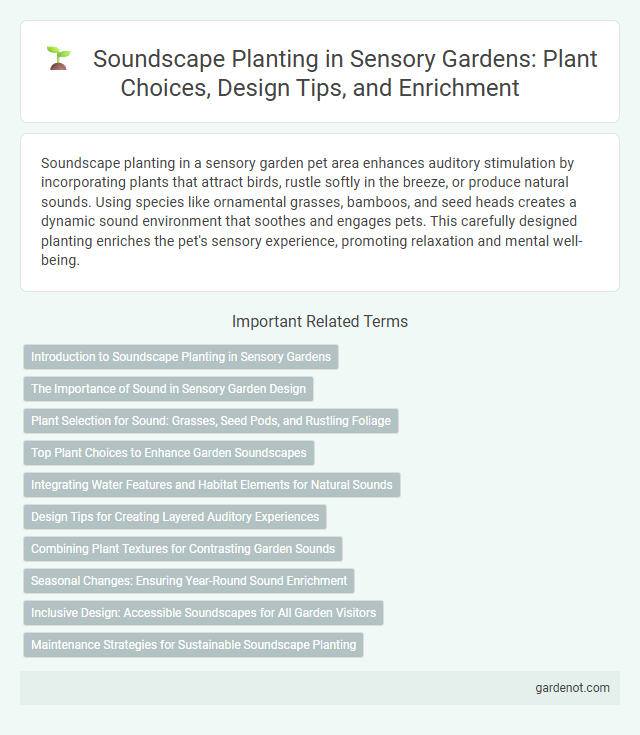Soundscape planting in a sensory garden pet area enhances auditory stimulation by incorporating plants that attract birds, rustle softly in the breeze, or produce natural sounds. Using species like ornamental grasses, bamboos, and seed heads creates a dynamic sound environment that soothes and engages pets. This carefully designed planting enriches the pet's sensory experience, promoting relaxation and mental well-being.
Introduction to Soundscape Planting in Sensory Gardens
Soundscape planting in sensory gardens enhances auditory experiences by incorporating plants that produce distinct natural sounds like rustling leaves, whispering grasses, and bird-attracting blossoms. Species such as ornamental grasses, bamboo, and seed-bearing plants create dynamic sound layers, enriching the environment for visitors with sensory impairments or mindfulness practices. Strategic placement of sound-producing flora transforms sensory gardens into immersive habitats that stimulate hearing and promote relaxation.
The Importance of Sound in Sensory Garden Design
Soundscape planting in sensory garden design enhances auditory stimulation, creating a tranquil environment that promotes relaxation and mindfulness. Incorporating rustling grasses, chimes, and water features enriches the soundscape, engaging visitors' senses and supporting emotional well-being. Strategic plant selection focusing on natural acoustic elements boosts sensory diversity and offers therapeutic benefits in outdoor spaces.
Plant Selection for Sound: Grasses, Seed Pods, and Rustling Foliage
Selecting plants with distinctive sound qualities enhances sensory gardens by incorporating auditory elements. Ornamental grasses such as Miscanthus and Pennisetum create soothing rustling sounds when the wind passes through their blades, while seed pods from species like Lunaria and Eryngium produce subtle rattling noises. Foliage with textured leaves, including plants like eucalyptus and bamboo, contributes to a dynamic soundscape by amplifying natural ambient sounds and inviting tactile interaction.
Top Plant Choices to Enhance Garden Soundscapes
Top plant choices for enhancing garden soundscapes include ornamental grasses like Miscanthus and Pennisetum, whose rustling leaves create soothing natural white noise. Bamboo varieties such as Phyllostachys provide gentle rhythmic sounds when their stalks sway in the wind, adding a dynamic auditory layer. Flowering shrubs like Viburnum and Lavender attract pollinators, contributing soft buzzing and subtle wildlife sounds that enrich the sensory garden experience.
Integrating Water Features and Habitat Elements for Natural Sounds
Soundscape planting in sensory gardens harnesses the gentle movement of water features such as fountains, streams, and ponds to create soothing natural acoustics that enhance user experience. Integrating habitat elements like bird-friendly shrubs, native grasses, and insect-attracting flowers promotes diverse wildlife activity, enriching the auditory environment with bird songs, insect buzzes, and rustling leaves. These components work synergistically to establish immersive, therapeutic soundscapes that support biodiversity and foster a deeper connection to nature.
Design Tips for Creating Layered Auditory Experiences
In soundscape planting, selecting a diverse array of plants that produce varying auditory effects, such as rustling leaves, gentle wind chimes, and bird-attracting flowers, enhances the sensory depth of a garden. Incorporating layers of vegetation with different heights and textures creates dynamic sound interactions, from the subtle whispers of ground cover to the crisp swishes of tall grasses. Strategic placement near pathways and seating areas maximizes the immersive auditory experience, fostering a tranquil environment that engages visitors' senses.
Combining Plant Textures for Contrasting Garden Sounds
Combining diverse plant textures such as tall grasses, dense shrubs, and soft-leaved herbs enhances the soundscape by creating contrasting auditory experiences in a sensory garden. Wispy grasses produce gentle rustling sounds, while broad-leaved shrubs offer muted silence, adding layers of sound variation. Strategic placement of these textures helps cultivate dynamic garden sounds that engage visitors and promote relaxation.
Seasonal Changes: Ensuring Year-Round Sound Enrichment
Soundscape planting in sensory gardens incorporates diverse plant species that produce varying sounds through seasonal changes, such as rustling grasses in autumn and bird-attracting blossoms in spring. Selecting evergreens alongside deciduous plants maintains year-round auditory interest by providing consistent wind sounds and supporting wildlife activity. Strategic arrangement of plants that respond to different weather conditions enriches the sensory experience through dynamic natural soundscapes throughout all seasons.
Inclusive Design: Accessible Soundscapes for All Garden Visitors
Soundscape planting in sensory gardens integrates diverse auditory elements such as rustling grasses, wind chimes, and water features to create inclusive environments that engage visitors with varying sensory abilities. Strategic placement of native plants like ornamental grasses and bamboo enhances natural sound diffusion, ensuring accessibility for individuals with hearing impairments and cognitive differences. Incorporating user-centered design principles fosters inclusive soundscapes that offer therapeutic benefits and enrich multisensory experiences for all garden visitors.
Maintenance Strategies for Sustainable Soundscape Planting
Soundscape planting requires tailored maintenance strategies that promote healthy vegetation and enhance acoustic qualities by regularly monitoring plant growth and managing species diversity. Utilizing low-maintenance, native plants reduces resource consumption while supporting natural sound absorption and wildlife habitats. Implementing seasonal pruning, selective mulching, and integrated pest management ensures sustainable soundscape function and longevity.
Soundscape planting Infographic

 gardenot.com
gardenot.com